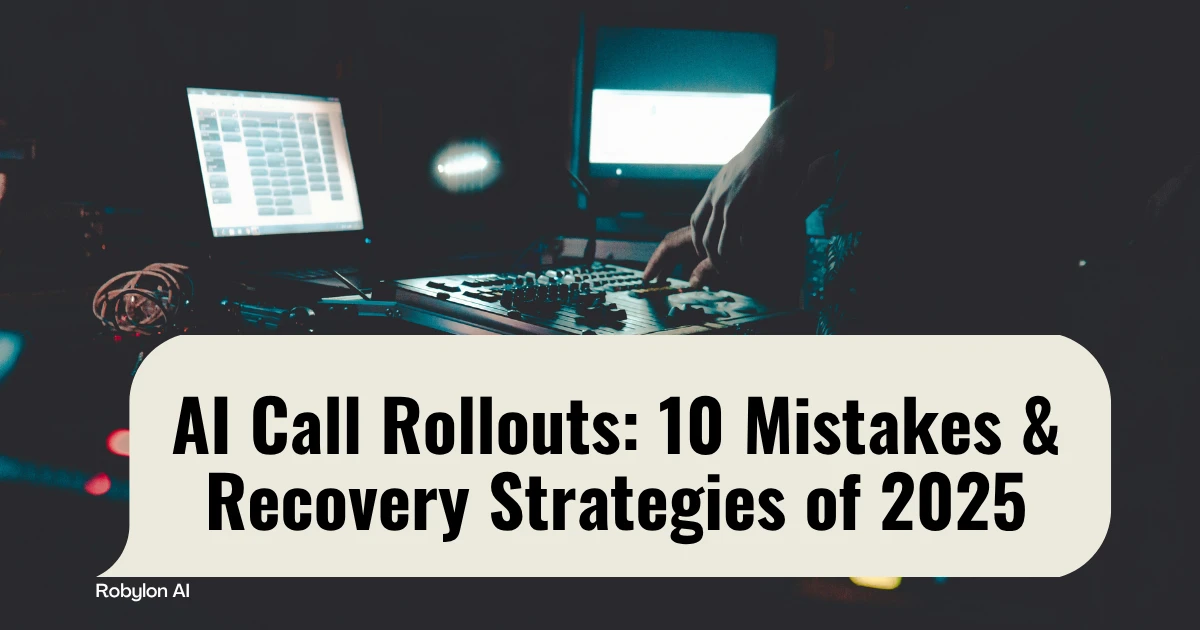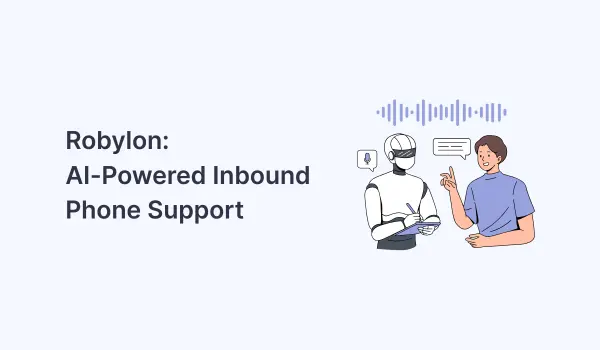TL;DR
Enterprises lose time and money when AI call rollout mistakes stack up, missed deadlines, cost overruns, and KPI misalignment. This guide names the common drivers of enterprise AI rollout failures, from AI voice agent deployment errors to broader AI call center implementation mistakes across IVR, deflection, and agent assist.
It is actionable, diagnostic, and ROI-centric with ten concrete pitfalls to avoid and a recovery framework for failed AI rollout that stabilizes service, restores KPIs, and protects budgets. Use it to move from stalled pilots to predictable performance and measurable outcomes.
Introduction
- Treating AI as plug-and-play: Scope intents, add escalation paths, enforce human-AI collaboration
- KPI misalignment: Re-set KPI hierarchy (containment, CSAT, AHT), rebuild dashboards tied to revenue
- Weak data foundations: Standardize data, label edge cases, add drift monitors, and feedback loops
- No governance or transparency: Stand up governance boards, versioning, audit trails, risk taxonomy
- Change-management blind spots: Map stakeholders, train agents, set incentives, run steady comms
- Missing human fallbacks: Create tiered handoffs, warm transfers, and deflection guardrails
- Poor backend integration: Prioritize CRM/order/identity APIs with idempotency, retries, and observability
- Underpowered infrastructure: Plan capacity, load test, autoscale, and monitor latency/uptime
- Pilot that never scales: Define graduation criteria, canary, then phased rollout with SLOs
- Budget overruns and hype: Build unit economics, set milestone gates, lock vendor SLAs, control scope
5-step “how to recover from AI rollout mistakes”: Diagnose → Stabilize → Fix foundations → Retrain and realign → Scale with guardrails
Cut time to resolution with AI agents. Book a demo
What Counts as an AI Call Rollout?
An AI call rollout refers to the end-to-end deployment of conversational AI across voice, IVR, call deflection, and agent-assist systems where automation interacts directly with customers or supports human agents in real-time.
A successful rollout goes beyond turning on a model. It requires solid backend integration with CRMs and ticketing systems, strong infrastructure readiness to handle live traffic, clear governance & transparency controls for compliance, and defined human oversight/fallback mechanisms to manage exceptions or failures.
Together, these dependencies ensure that AI performs reliably, scales safely, and delivers measurable ROI.
10 AI Call Implementation Errors Enterprises Make
1) Treating AI as Plug-and-Play
Many enterprises still treat AI call rollouts as simple software installs; deploy and forget. But conversational AI deployment demands structured data, iterative training, and cross-team coordination.
What it is: Assuming AI will “just work” without integration or tuning
Symptoms: Low accuracy, inconsistent responses, weak escalation logic
Impacted KPIs: Containment ↓, CSAT ↓, Escalations ↑
Recovery Steps
- Re-scope intents and escalation paths
- Add human-AI collaboration SOPs
- Implement phased pilot scaling with QA gates
Prevention Checklist: Integration checklist, sandbox validation, fallback, and feedback loops
2) KPI Misalignment from Day One
AI success isn’t about fancy dashboards; it is about business outcomes. Many teams track vanity metrics that don’t tie to revenue or CX impact.
What it is: Poor alignment between business goals and AI performance metrics
Symptoms: Average Handle Time (AHT) improves, but CSAT or conversions drop
Impacted KPIs: CSAT, First Contact Resolution (FCR), Average Handle Time (AHT), Containment
Recovery Steps
- Re-prioritize KPI hierarchy (containment > CSAT > AHT)
- Rebuild dashboards tied to business value
- Assign clear KPI owners
Prevention Checklist: Define success early, capture pre-rollout baselines, and validate ROI alignment
3) Weak Data Foundations
Without reliable data, even the smartest AI will fail. Enterprise AI rollout failures often stem from poor data quality challenges and unmanaged training sets.
What it is: Inconsistent, outdated, or biased data undermining model accuracy
Symptoms: Misinterpretations, repeated user queries, poor recommendations
Impacted KPIs: Accuracy %, First Contact Resolution (FCR), Resolution Time
Recovery Steps
- Normalize data and label edge cases
- Add drift monitoring and user feedback loops
Prevention Checklist: Data contracts, retraining cadence, automated QA pipelines
4) No Governance or Transparency
When AI runs unchecked, risk multiplies, lack of AI governance frameworks leads to compliance issues and erratic behavior.
What it is: Missing guardrails for model decisions and audit tracking
Symptoms: Inconsistent tone, compliance violations, uncontrolled outputs
Impacted KPIs: Quality adherence, audit compliance, error rate
Recovery Steps
- Establish review boards and risk taxonomy
- Version all model changes
- Build audit trails and red-team tests
Prevention Checklist: Governance playbooks, approval workflows, periodic reviews
5) Change Management Blind Spots
Even great AI fails if people don’t adopt it. AI change management mistakes stem from poor training and weak stakeholder communication.
What it is: Employees are unprepared for workflow and collaboration changes
Symptoms: Agent resistance, inconsistent usage, productivity loss
Impacted KPIs: Adoption rate, CSAT, Efficiency
Recovery Steps
- Build stakeholder maps
- Train agents with clear incentives
- Maintain a steady communication cadence
Prevention Checklist: Early involvement, transparent expectations, feedback channels
6) Missing Human Fallbacks
AI isn’t perfect; it needs backup, and a missing human oversight/fallback plan can tank customer trust in seconds.
What it is: No smooth transition from AI to human support
Symptoms: Dead-end calls, repeated loops, unresolved tickets
Impacted KPIs: CSAT, First Contact Resolution (FCR), Abandonment Rate
Recovery Steps
- Enable tiered handoffs and warm transfers
- Set escalation guardrails
Prevention Checklist: Human-in-loop routing, fallback analytics, escalation alerts
7) Poor Backend Integration
Disconnected systems kill context, and AI integration pitfalls often block visibility across CRMs, order systems, and tickets.
What it is: AI can’t read/write from key systems
Symptoms: Missing customer context, duplicate records, failed updates
Impacted KPIs: Resolution time, Containment, Call duration
Recovery Steps
- Prioritize core API integration (CRM, Orders, Identity)
- Add retries, idempotency, and observability
Prevention Checklist: Staging tests, API dashboards, alerting for errors
8) Underpowered Infrastructure
AI call systems demand performance, while infrastructure readiness failures cause dropped calls and poor response latency.
What it is: Inadequate compute, bandwidth, or concurrency planning
Symptoms: Lag, call drops, delayed model responses
Impacted KPIs: Uptime, Latency, Concurrency
Recovery Steps
- Run load tests and plan capacity
- Enable autoscaling and observability pipelines
Prevention Checklist: Infra audits, resilience testing, real-time monitoring
9) Pilot That Never Scales
Enterprises love pilots, but many never graduate them. Common AI implementation mistakes in call centers stem from unclear success gates.
What it is: Endless testing without enterprise rollout
Symptoms: Repeated pilots, stalled ROI, low adoption
Impacted KPIs: ROI, Adoption %, Cost per Interaction
Recovery Steps
- Define graduation criteria and rollout phases
- Move from sandbox → canary → full launch
Prevention Checklist: Success scorecards, SLOs, and phase reviews
10) Budget Overruns & Unrealistic Expectations
AI success requires realism. Overpromised ROI and avoiding AI rollout budget overruns remain top enterprise risks.
What it is: Underestimated costs and inflated vendor promises
Symptoms: Scope creep, delayed value, rising Operating Expenditure (OPEX)
Impacted KPIs: ROI, Customer Acquisition Cost (CAC), Cost per Call
Recovery Steps
- Build a unit-economics model
- Set milestone gates and SLA reviews
- Re-scope contracts quarterly
Prevention Checklist: Forecast total cost of ownership (TCO), usage alerts, vendor health checks
The 5-Step Recovery Framework (Use This If Your Rollout Is Struggling)
The following five-step recovery framework provides an actionable path to diagnose, stabilize, and scale your deployment while preventing further losses.
1. Diagnose the Gap (KPI & Voice-of-Customer)
The first step in recovery is understanding where things went wrong. Map your KPI misalignment using quantifiable indicators like CSAT, average handle time (AHT), first contact resolution (FCR), and containment. Analyze voice-of-customer data to identify friction points and patterns driving your AI project failure rate.
Action points
- Benchmark pre-rollout vs. post-rollout metrics
- Segment issues by intent, channel, and escalation cause
- Use analytics tools to isolate the biggest ROI gaps
2. Stabilize the Experience (Human Oversight / Fallback)
Introduce human oversight/fallback workflows to manage errors and restore customer trust. This ensures seamless handoffs and prevents prolonged failure loops in AI voice agent rollouts.
Action points
- Route complex calls to trained human agents
- Enable tiered escalation triggers for unresolved cases
- Use fallback tracking to measure recovery efficiency
3. Fix the Foundation (Data, Integrations, Infrastructure)
Once stability is restored, address the root cause. Most enterprise AI rollout failures stem from data quality challenges, fragmented systems, and weak infrastructure readiness.
Action points
- Standardize and label datasets to eliminate ambiguity
- Strengthen backend integration (CRM, order, identity systems)
- Run infrastructure load tests and enable autoscaling for concurrency
4. Retrain & Realign (Models + Playbooks)
AI performance decays without retraining. Tackle model drift and optimize continuous training & retraining cycles using updated playbooks and clear governance & transparency controls.
Action points
- Establish a retraining cadence based on data drift detection
- Redesign prompt and escalation logic for accuracy
- Set up governance boards to validate every model update
5. Scale with Guardrails (Pilot → Production)
Finally, reintroduce your AI to production, but do it gradually. Controlled pilot scaling supported by AI governance frameworks prevents repeating earlier rollout mistakes.
Action points
- Define graduation criteria for each pilot phase
- Monitor cost-to-serve, performance KPIs, and SLA adherence
- Conduct post-mortems after each expansion stage
Steer Clear of Common AI Pitfalls
Artificial Intelligence holds immense promise, but success depends on execution discipline. Avoiding these ten mistakes, from weak governance to missing fallbacks, is what separates scalable programs from failed experiments.
Remember: AI transformation is a continuous journey, not a single project. Sustained results come from clarity of goals, rigorous testing, strong data governance, and proactive team alignment. With prudence, structure, and consistent measurement, AI call rollouts evolve from cost centers into measurable business growth engines.
Measurement
Tie every fix back to numbers, connect AI call center implementation mistakes to changes in service and cost. Track a simple chain: input change → KPI delta → financial impact.
Core KPIs to track
- CSAT, average handle time (AHT), first contact resolution (FCR), deflection, containment, conversion
- Cost per call, cost-to-serve, backlog burn, uptime/latency
Time-to-Value (TTV)
- Define “value ready” as stable KPIs for two consecutive weeks
- Time to Value (TTV) = go-live date to first sustained KPI improvement
ROI formula
- ROI = (Added revenue + Cost saved − Program cost) ÷ Program cost
- Cost saving includes reduced handle time, deflections, and avoided recontacts
AI project failure rate reduction
- Baseline your AI project failure rate across pilots and rollouts
- Count pilots that miss KPI targets or halt in 90 days
- Show quarter-over-quarter drop after applying the recovery framework
- Target a 30–50% reduction by quarter two, then hold
Pro Tips & Advanced Patterns
- Human-AI collaboration routing trees: Route by confidence, sentiment, and user tier, log every handoff
- Safety controls: Human oversight/fallback triggers on low confidence, policy risk, or repeated loops
- Multi-model strategy: Blue/green releases, champion/challenger tests with holdouts, cost controls per model family.
Upgrade your dashboard with these 12 must-track AI call metrics.
How to Measure ROI After Recovery
Outcome Metrics
Track CSAT lift after fixes to escalation logic and prompts. Measure First Contact Resolution (FCR) gains from better data and backend integration. Record average handle time (AHT) reduction from agent-assist flows. Monitor containment in self-serve, attribute conversion, or upsell to qualified transfers.
Cost Metrics
Calculate cost-to-serve using telephony, model usage, and staffing. Track the cost per resolved call before and after recovery. Watch infrastructure spending during scale to avoid new cost overruns.
Risk & Quality
Reduce escalation rate with clear fallbacks. Detect model drift with automated evals and data checks. Keep error bands inside SLOs. Run weekly QA sampling on transcripts and outcomes.
Conclusion: Turn AI Setbacks into Scalable Wins
Enterprise AI rollouts don’t fail because the technology isn’t ready; they fail because teams skip the fundamentals: strategy, governance, and measurement. Every issue outlined in this guide, whether it’s data quality challenges, AI integration pitfalls, or KPI misalignment, is fixable with structure, ownership, and the right platform.
At Robylon AI, we have seen enterprises recover from 40% automation rates to 85%+ within months by following a structured recovery plan rooted in governance, retraining, and ROI-driven scaling; the secret lies in treating AI as a system, not a side project.
Book a demo, see how Robylon’s enterprise-grade AI agents recover failed pilots, automate faster, and deliver measurable business impact.
FAQs
What governance is needed for AI deployment in enterprises?
Adopt AI governance frameworks with review boards, approval workflows, and versioned prompts/policies. Add audit trails, red-team tests, and transparency reports. Define escalation rules and human oversight/fallback, governance reduces risk, speeds safe releases, and ensures compliance for AI call center implementation mistakes you want to avoid.
What infrastructure is needed for conversational AI?
Plan for low-latency STT/TTS, GPU/CPU capacity, concurrency management, and resilient telephony. Add observability (traces, logs, metrics), autoscaling, and circuit breakers to meet infrastructure readiness goals. Validate performance with load tests and failover drills to protect uptime and call quality during spikes in demand.
How to scale AI pilots to full deployment?
Adopt structured pilot scaling: sandbox → canary → phased rollout
Define exit criteria, SLOs, and guardrails for latency, accuracy, and cost. Monitor cost-to-serve to avoid overruns, and run champion/challenger tests before broad release. This converts pilot gains into enterprise value while reducing common AI implementation mistakes in call centers.
How to align AI with business goals, not just tech goals?
Build a KPI tree that links models to outcomes (containment, CSAT, conversion, cost per call). Secure executive sponsorship and review progress monthly. Replace vanity metrics with value tracking, and document trade-offs (e.g., AHT vs. CSAT). This reduces KPI misalignment and ensures AI funds the roadmap through measurable, business-level impact.
What are the risks of deploying AI voice agents in contact centers?
Key risks include privacy and bias exposure, AI voice agent deployment errors, and missing escalation routes. Mitigate with encryption, redaction, and fairness checks. Enforce human oversight/fallback on low confidence, and log every transfer. Add prompt controls, monitoring, and audit trails to meet compliance while protecting CSAT and brand trust.
How can an enterprise recover from a failed AI rollout?
Use a five-step recovery framework for failed AI rollout: diagnose KPI gaps, stabilize with human oversight/fallback, fix foundations (data, integrations, infrastructure), retrain models to address model drift, and scale via pilot gates with SLOs. Tie changes to ROI and cost-to-serve, then publish a governance calendar to keep improvements durable.
Why do AI projects fail in enterprises?
Failures usually stem from data quality challenges, KPI misalignment, and poor change management. Models ship without clean training data, metrics don’t map to business value, and teams lack enablement. Add governance reviews, role-based training, and baseline KPIs (CSAT, AHT, FCR, containment).
What are the biggest mistakes when rolling out AI in enterprises?
The most common issues include AI call rollout mistakes like treating systems as plug-and-play, weak data foundations, and missing governance & transparency. Teams skip integration and change management, causing KPI drops and cost overruns.
A clear scope, pilot criteria, data standards, and governance reviews prevent rework and keep performance stable across IVR, deflection, and agent-assist use cases.







.png)





.webp)












